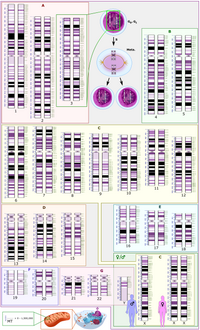
Photo from wikipedia
Abstract Analysis of human exome sequences, the protein-coding regions of genomes, has the potential to identify variation in genes relevant to disease for expedited clinical and therapeutic translation. Here we… Click to show full abstract
Abstract Analysis of human exome sequences, the protein-coding regions of genomes, has the potential to identify variation in genes relevant to disease for expedited clinical and therapeutic translation. Here we present results from a massive-scale type 2 diabetes (T2D) exome sequencing project. We analyzed exomes from 20,791 participants with T2D and 24,440 controls from five ancestries (Hispanic/Latino 33.8%, European 24.6%, African-American 13.9%, East Asian 14.1%, South Asian 13.6%) with mean depth 40x, and conducted both single-variant and gene-level association testing. Eighteen single-variant signals reached exome-wide significance (p< 4.3×10-7); all were common variants (minor allele frequency [MAF] > 5%) except MC4R p.Ile269Asn, which was almost exclusively seen in Hispanic/Latinos with MAF 0.89% and T2D OR=2.17 (95% CI: 1.63-2.89) in that population. Only one single-variant association represented a previously unknown T2D genetic locus (SFI1 p.Arg724Trp), but this finding failed to replicate in an independent cohort. We identified gene-level associations composed of rare (MAF < 0.5%) variants (a) in three genes each reaching a gene-level exome-wide significance threshold of 6.57×10-7 (MC4R, PAM, and SLC30A8), including a T2D protective series of >30 SLC30A8 alleles, and (b) within 12 gene sets, including those corresponding to known T2D drug targets (p=6.1×10-3) and candidate genes from knockout mice (p=5.2×10-3). These aggregate gene-level associations suggest that larger sample sizes will allow more refined identification of novel T2D genes, including potential new drug targets. Based on the rare-variant gene-level effect sizes we observed in established T2D drug targets, we estimate that 110K-180K sequenced cases would be required for reliable identification of new T2D drug targets. Additionally, we have developed a Bayesian framework using our association results to facilitate prioritization of genes for translational decision support.
Journal Title: Journal of the Endocrine Society
Year Published: 2019
Link to full text (if available)
Share on Social Media: Sign Up to like & get
recommendations!